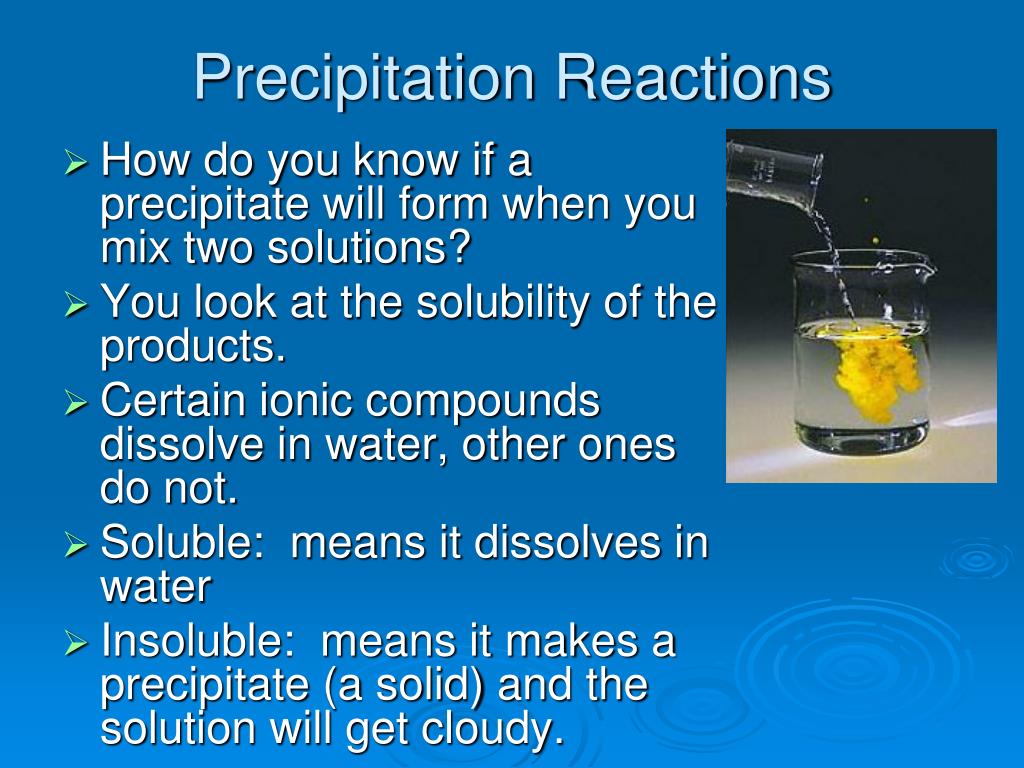

The physico-chemical process underlying digestion is called Ostwald ripening. It results in purer and larger recrystallized particles. The compact mass thus obtained is sometimes referred to as a 'pellet'.ĭigestion and precipitates ageing ĭigestion, or precipitate ageing, happens when a freshly formed precipitate is left, usually at a higher temperature, in the solution from which it precipitates. Sedimentation can be accelerated by high speed centrifugation. Without sufficient attraction forces ( e.g., Van der Waals force) to aggregate the solid particles together and to remove them from solution by gravity ( settling), they remain in suspension and form colloids. Similar processes are often used in sequence – for example, a barium nitrate solution will react with sulfate ions to form a solid barium sulfate precipitate, indicating that it is likely that sulfate ions are present. To identify the cation, the color of the precipitate and its solubility in excess are noted. To do this, an alkali first reacts with the unknown salt to produce a precipitate that is the hydroxide of the unknown salt. Precipitate formation is useful in the detection of the type of cation in a salt. Inorganic chemistry Precipitation in aqueous solution If energy changes are not favorable, or without suitable nucleation sites, no precipitation occurs and the solution remain supersaturated.
When does precipitate form in a chemical reaction free#
This involves energy changes depending on the dissolution reaction free energy ( endothermic or exothermic process accompanied by an entropy increase) and the relative surface energy developed between the solid and the solution. The creation of a solid particle implies the formation of an interface with the solution.

When a potassium iodide solution reacts with a lead(II) nitrate solution, a yellow precipitate of lead(II) iodide is formed.Īn important stage of the precipitation process is the onset of nucleation. When a barium chloride solution reacts with sulphuric acid, a white precipitate of barium sulfate is formed. The formation of a precipitate can be caused by a chemical reaction. Precipitation occurs more rapidly from a strongly supersaturated solution. This can be due to temperature changes, solvent evaporation, or by mixing solvents.

The precipitation of a compound may occur when its concentration exceeds its solubility. The notion of precipitation can also be extended to other domains of chemistry (organic chemistry and biochemistry) and even be applied to the solid phases ( e.g., metallurgy and alloys) when solid impurities segregate from a solid phase. The clear liquid remaining above the precipitated or the centrifuged solid phase is also called the ' supernate' or ' supernatant'. In case of an inorganic chemical reaction leading to precipitation, the chemical reagent causing the solid to form is called the precipitant.

The solid formed is called the precipitate. In an aqueous solution, precipitation is the process of transforming a dissolved substance into an insoluble solid from a super-saturated solution. Once the precipitate has been recovered, the resulting powder may be called a "flower.Principle of chemical precipitation in aqueous solution A common sedimentation technique is centrifugation. Sedimentation refers to any procedure that separates the precipitate from the liquid portion of the solution, which is called the supernate. If the particle size of the insoluble compound is very small or there is insufficient gravity to draw the solid to the bottom of the container, the precipitate may be evenly distributed throughout the liquid, forming a suspension. The solid that is formed is called the precipitate. A chemical that causes a solid to form in a liquid solution is called a precipitant. Here's how it works: forming a solid from a solution is called precipitation. The terminology can seem a bit confusing. They are used for purification, removing or recovering salts, for making pigments, and to identify substances in qualitative analysis.


 0 kommentar(er)
0 kommentar(er)
